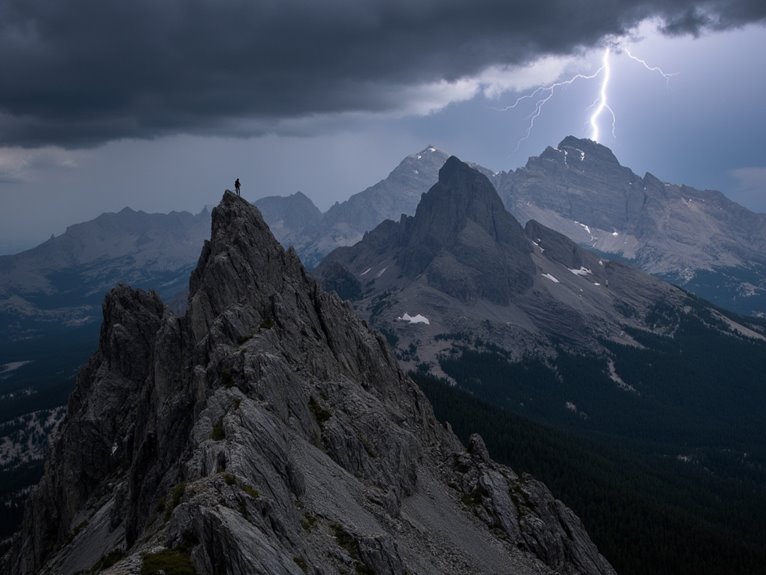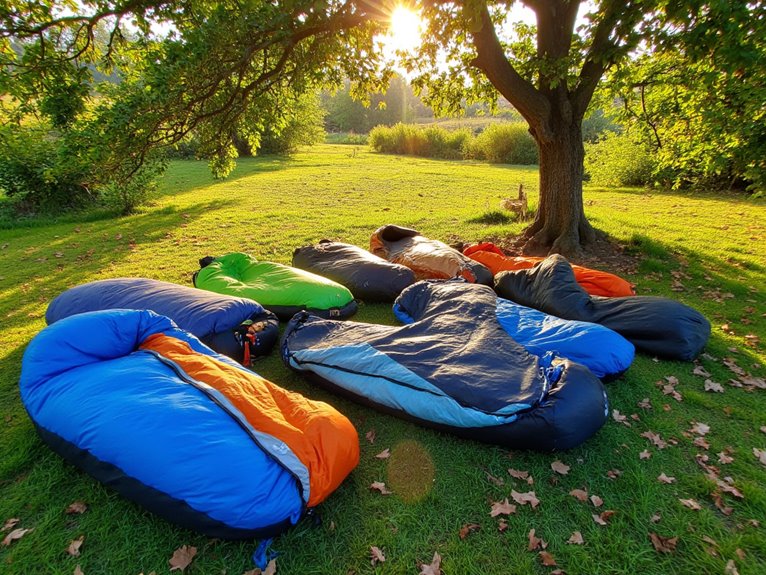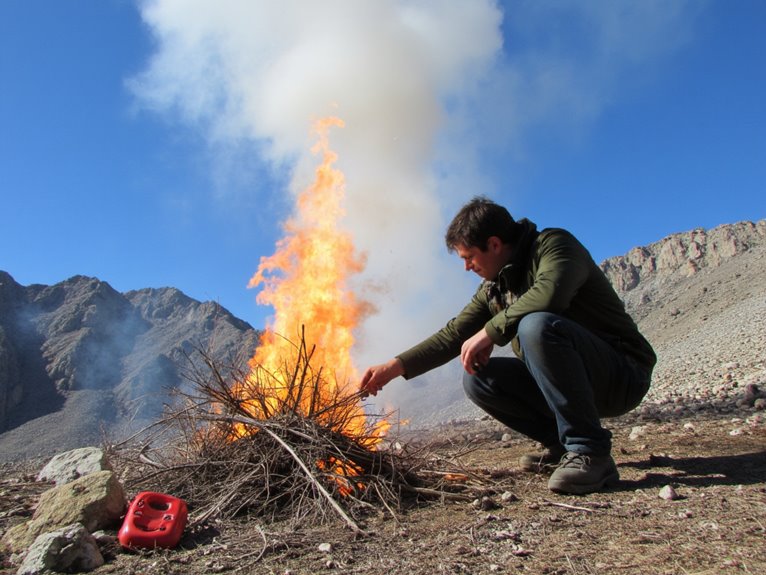Lightning Safety Above Treeline: Escape Routes and Timing
Above treeline, you’re exposed terrain where 95-97% of lightning injuries occur from ground currents rather than direct strikes. Plan primary descent routes to treeline before your trip and set firm turn-back times based on typical afternoon storm development. Start early morning when atmospheric conditions remain stable. Seek immediate shelter when thunder follows lightning within 30 seconds, then wait 30 minutes after the last thunder. Understanding proper emergency positioning and recognizing critical storm indicators can greatly improve your survival odds in exposed alpine environments.
We are supported by our audience. When you purchase through links on our site, we may earn an affiliate commission, at no extra cost for you. Learn more. Last update on 8th January 2026 / Images from Amazon Product Advertising API.
Notable Insights
- Plan escape routes to treeline before trips and document descent paths on physical maps since electronics may fail during storms.
- Start early morning when atmospheric conditions are more stable, as thunderstorms typically develop during late afternoon hours.
- Set firm turn-back times based on calculated descent duration and typical storm development patterns to ensure safe retreat.
- Seek immediate shelter when thunder follows lightning in under 30 seconds, remaining sheltered 30 minutes after last thunder.
- Avoid terrain traps like gullies and exposed ridges; head for forested areas below treeline which provide superior lightning protection.
Understanding Your Risk Above Treeline

When you venture above treeline, you’re entering one of nature’s most electrically dangerous environments where your risk of lightning strike increases dramatically.
Above treeline, you become the highest point in an electrically charged landscape where lightning strikes with deadly precision.
Mountain peaks and ridges act as natural lightning rods, providing the path of least resistance for electrical discharge from storm clouds to ground. Without tall trees or structures to intercept strikes, you become the highest point on exposed terrain.
Risk awareness becomes critical as thunderstorms can generate lightning strikes up to 10 miles away from the storm itself.
Summer months present peak danger when thunderstorm activity coincides with heavy recreational use. Terrain familiarity helps you identify escape routes before storms develop.
Ridge lines, knife-edge crests, and false summits concentrate electrical fields and represent maximum exposure points you must avoid during any storm activity.
How Lightning Actually Injures and Kills
You might think a direct lightning strike poses the greatest danger, but that’s not how most casualties occur above treeline.
Ground current actually causes the majority of lightning injuries and deaths in exposed terrain, flowing through your body when strikes hit nearby rocks, ridges, or peaks.
While direct strikes affect only 3-5% of victims, ground current spreads outward from strike points through wet soil and rock, making it the dominant threat you’ll face in alpine environments.
Direct Strike Versus Indirect
Although lightning strikes appear identical to the untrained eye, the mechanisms by which they injure and kill differ dramatically between direct and indirect encounters.
A direct strike occurs when lightning’s current flows directly through your body as part of the flash channel. This represents only 3-5% of all lightning injuries but causes severe electroporation damage to nerves and muscles. The current moves along your skin surface before entering your body, creating internal burns and organ damage.
| Strike Type | Frequency | Primary Mechanism |
|---|---|---|
| Direct | 3-5% | Current through body |
| Indirect | 95-97% | Contact/side splash |
| Combined | 100% | Various pathways |
An indirect strike involves contact injuries, side splashes, or blast effects from nearby lightning. Though more common, indirect strikes typically cause less severe injuries than direct encounters.
Ground Current Dominates Casualties
The ground beneath your feet becomes a deadly conductor when lightning strikes nearby terrain. Ground current effects account for 50-55% of all lightning casualties, making this the primary injury mechanism you’ll face above treeline.
When lightning hits, electrical current spreads radially through the earth, creating voltage gradients that drive current through your body. You’re at risk even 100 feet from the strike point because your body conducts electricity better than soil.
The current typically travels up one leg and down the other, causing burns, cardiac arrest, and rhabdomyolysis. Injury mechanisms depend on current pathway, voltage levels, and contact duration.
Keep your feet together to minimize voltage differential. Never lie flat, as this increases your body’s ground contact area and exposure to electrical flow.
Pre-Trip Route Planning for Storm Scenarios
When lightning threatens above treeline, your survival depends on decisions made long before you step foot on the mountain.
Effective route selection requires identifying primary descent paths that reach treeline fastest from your intended summit. Map secondary escape routes as backup options when primary paths become unsafe.
Calculate descent times from your furthest point to safety, including margins before afternoon storms typically develop. Set firm turn-back times based on these calculations. Document escape planning details on physical maps-electronics fail during storms.
Avoid terrain traps like gullies and exposed ridges that increase lightning risk.
Establish clear group protocols for initiating descents and regrouping procedures. Pre-register your route plans with local authorities, including contingency options.
Practice navigation skills and rapid descent techniques before departure.
Pack lightweight down jackets in your emergency gear to maintain core warmth during unexpected overnight stays if storm conditions prevent safe descent to treeline.
Recognizing Weather Warning Signs
You can identify approaching thunderstorms through three critical monitoring methods that work together to provide early warning above treeline.
Early storm development signs include visual cues like towering cumulonimbus clouds and darkening skies, while audio indicators such as buzzing sounds from metal objects and hair standing on end signal dangerous electrical activity.
Technology weather monitoring tools like mountain-specific forecasts and real-time weather apps complement your direct observations to create a thorough storm detection system.
Early Storm Development Signs
How can you identify approaching thunderstorms before they become life-threatening above treeline?
Watch for rapid storm cloud formation, particularly large, puffy cumulus clouds that develop quickly. These vigorous clouds indicate atmospheric instability and can spawn dangerous thunderstorms within minutes.
Monitor temperature shifts carefully-drastic drops signal incoming storms, especially when temperatures decrease faster than 5°F per 1,000 feet of elevation.
You’ll notice sudden wind direction changes as storms approach. Fair weather winds typically flow west to east, but shifting patterns indicate atmospheric disturbance. Increased wind speeds accompany these directional changes.
Pay attention to humidity levels, as high moisture content fuels thunderstorm development. Mountain terrain amplifies these conditions through orographic lift, forcing air masses upward and intensifying precipitation potential.
When storms do arrive, ensure you have waterproof protection with a hydrostatic head rating above 10,000mm to withstand sustained downpours that often accompany mountain thunderstorms.
Visual and Audio Cues
Several distinct visual and audio warning signs provide critical early detection of dangerous weather conditions above treeline.
Cloud formations serve as your primary visual indicators for approaching storms. Lenticular clouds signal high winds and turbulence near mountain peaks, while banner clouds streaming off summits reveal wind direction and strength. Rapidly moving clouds indicate strong winds and potential storm activity.
Audio cues complement visual observations for extensive weather assessment:
- Thunder sounds – Indicates lightning presence; closer thunder means closer strikes
- Wind whistling – Through terrain features signals dangerous wind speeds
- Electric crackling – In the air may precede lightning strikes
- Nature silence – Sudden quiet indicates animals seeking storm shelter
Tall cumulus clouds can rapidly develop into thunderstorms, requiring immediate descent planning. When preparing for exposed alpine conditions, ensuring your weather protection gear can withstand wind and precipitation becomes essential for both safety and maintaining body temperature during emergency descents.
Technology Weather Monitoring Tools
While your senses provide valuable early warning signals, modern technology offers precise lightning detection capabilities that extend far beyond human perception limits. Handheld lightning detectors like the SkyScan P5-3 identify electromagnetic pulses within a 40-mile radius. These sensor technologies categorize strikes into specific distance ranges and provide real-time alerts through visual and audible feedback.
| Device Type | Detection Range | Key Features |
|---|---|---|
| Handheld Detectors | 0-40 miles | Portable, immediate feedback |
| Weather Stations | 6.2 miles | Multi-parameter monitoring |
| Forecast Services | 60-minute advance | Predictive analytics |
| Professional Systems | 1-100 km | Historical data analysis |
| Cloud-Connected | Variable | Remote monitoring capability |
Advanced weather stations integrate lightning sensors with wind, temperature, and pressure measurements, enabling thorough storm tracking for critical safety decisions above treeline.
Optimal Timing for Alpine Activities
When planning alpine adventures above treeline, the timing of your activities can mean the difference between a successful outing and a dangerous encounter with lightning.
Alpine hiking requires careful attention to weather patterns and storm development cycles. Thunderstorms typically build during late afternoon hours, making early morning starts essential for safety. Summer months present the highest risk period for electrical activity above treeline.
Follow these critical timing protocols:
- Start before dawn – Begin alpine hiking during early morning hours when atmospheric conditions remain stable.
- Monitor the 30-second rule – Seek immediate shelter when thunder follows lightning by less than 30 seconds.
- Plan turnaround times – Calculate descent schedules allowing safe return before afternoon storm development.
- Wait 30 minutes – Remain sheltered for at least 30 minutes after the last thunder before resuming activities.
When venturing into exposed alpine terrain, selecting four-season tents with high waterproof ratings ensures reliable protection during unexpected severe weather conditions that can develop rapidly above treeline.
Safe Terrain Features During Storms
Even with perfect timing, storms can develop rapidly above treeline, making terrain selection your primary defense against lightning strikes.
You’ll want to identify safe terrain features before storms arrive. Forested areas below treeline provide superior protection compared to exposed ridgelines or summits.
Seek low rolling terrain, dry ravines, and closed valleys that won’t make you the tallest object in the landscape.
Avoid exposed summits, ridgelines, and tall solitary objects like lone trees. Standing water bodies conduct electricity and increase strike risk. Metal objects amplify danger. Lower elevations reduce your lightning profile greatly.
During safer excursions, assess terrain continuously for potential shelter options.
Depressions and valleys offer natural protection unless flash flooding threatens.
Remember: being the highest point makes you a lightning rod.
Dangerous Shelter Myths Debunked
Despite widespread acceptance of certain lightning safety practices, many commonly believed protective measures create dangerous false confidence rather than actual protection.
Shelter myths endanger lives through misguided assumptions about lightning behavior. Tent safety represents a critical misconception-fabric structures provide zero protection from electrical strikes. Research shows more lightning fatalities occur while camping than hiking during storms.
Four deadly shelter myths you must abandon:
- Lightning position crouching – No evidence supports this posture’s effectiveness against strikes.
- Cave protection – Ground currents and electrical arcing make rocky overhangs hazardous.
- Metal attraction theory – Lightning targets height and conductivity pathways, not jewelry or phones.
- Tree shelter – Standing under trees causes the second-highest number of lightning injuries.
Only fully enclosed buildings with electrical systems or metal vehicles offer genuine protection. Natural shelters and camping equipment can’t replicate Faraday cage effects necessary for safety.
Emergency Positioning When Caught Exposed
Getting caught exposed during a lightning storm requires immediate implementation of specific emergency positioning protocols that can significantly reduce your risk of injury or death.
Assume the crouching position immediately: feet together, head down, hands on knees. This stance minimizes your body’s height while reducing ground current exposure through a smaller contact area.
Use insulating materials when available. Crouch on a dry backpack or sleeping pad to further isolate yourself from ground currents. Remove all metal items including crampons, which can cause severe burns during strikes.
Space group members at least 50 feet apart to prevent multiple casualties from a single strike.
Maintain this position until the storm completely passes, typically 30 minutes after the last thunder.
Group Safety Protocols During Lightning Events
When lightning threatens your group above treeline, coordinated safety protocols become critical for preventing multiple casualties and ensuring everyone’s survival. Effective group communication prevents confusion during rapid weather changes. Everyone must understand the predetermined escape plan and meeting locations.
Implement these essential protocols immediately:
- Maintain 50-100 foot spacing between members to minimize multiple strike injuries
- Remove all metal equipment including backpack frames, trekking poles, and carabiners
- Descend to lower terrain while avoiding isolated trees and dry washes
- Use flash-bang timing to monitor storm distance and movement patterns
Proper hazard management requires constant weather monitoring and coordinated movement. Designate one member to track lightning intervals using the 30-30 rule.
Stay separated but visible during descent. Wait thirty minutes after the last thunder before regrouping.
Frequently Asked Questions
Can Lightning Strike the Same Place Twice During a Storm?
Yes, lightning strikes can absolutely hit the same place twice during a single storm.
You’ll find that tall, isolated objects face repeated strikes within minutes or even seconds. Storm frequency increases strike probability at identical locations because upward streamers create easier electrical paths.
Ground conductivity and terrain features make certain spots more attractive targets, explaining why skyscrapers regularly experience multiple lightning strikes during individual storm events.
How Far Away Can Lightning Still Be Dangerous to Hikers?
Lightning strikes pose danger up to 10 miles from their origin point.
You’re not safe even when storms appear distant. Safe distances require you to be indoors or in substantial shelter with grounded electrical systems.
The 30/30 rule applies: seek shelter when thunder follows lightning by 30 seconds or less, then wait 30 minutes after the last thunder before resuming outdoor activities.
Should I Turn off My GPS and Phone During Thunderstorms?
You should place your GPS and phone in airplane mode during thunderstorms rather than completely turning them off.
GPS functionality remains available in airplane mode while eliminating dangerous cellular transmission signals. Phone safety improves greatly since you’re not actively transmitting electromagnetic signals that could attract lightning.
Keep devices away from your body and store them in your pack’s interior compartments for additional protection.
Is It Safer to Lie Flat or Crouch When Lightning Approaches?
You shouldn’t choose between lying flat or crouching low when lightning approaches-both are dangerous options.
Lying flat increases your ground contact area, exposing you to deadly ground current from nearby strikes. Crouching low is only a last resort when shelter’s impossible.
Instead, you must immediately move to proper shelter like substantial buildings or enclosed vehicles.
Speed to safety trumps any protective position.
How Long Should I Wait After the Last Thunder Before Resuming Hiking?
You should wait 30 minutes after hearing the last thunder before safe resumption of hiking.
This thunderstorm timing follows the 30/30 Rule used by meteorologists and safety experts.
Thunder indicates lightning activity within approximately 10 miles of your location.
The 30-minute waiting period guarantees the storm has moved sufficiently far away to reduce strike risk to acceptable levels before you resume outdoor activities.
On a final note
You’ve learned the critical elements of alpine lightning safety: route planning, weather recognition, terrain selection, and emergency positioning. Lightning strikes kill within microseconds through cardiac arrest or respiratory failure. Your survival depends on pre-trip planning and immediate response to storm signs. Start early, turn around at the first thunderclap, and seek proper shelter below treeline. Don’t rely on myths-follow proven protocols. Your decisions determine whether you’ll return safely from exposed terrain.





